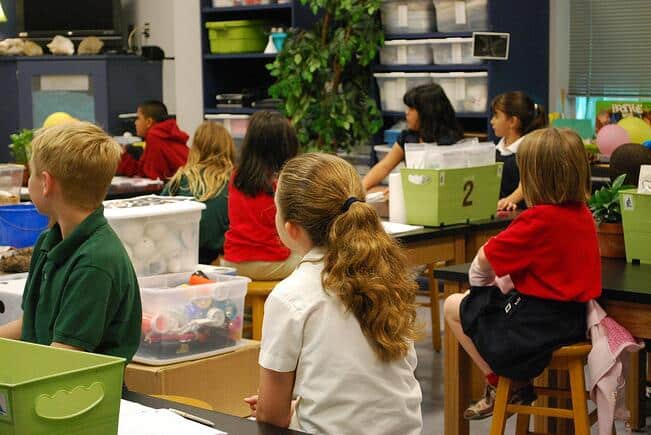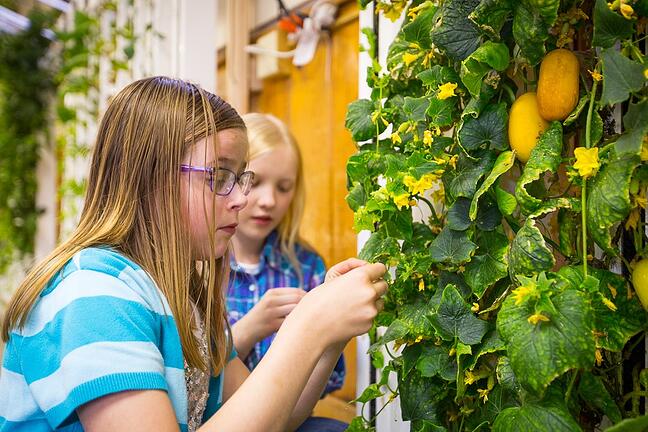New Problems, New Tools
While today’s educators face their own unique challenges, there has never been a better time to be teaching STEM subjects. Public opinion, movements like the local farming and urban ag movements, and a burst in agricultural innovation are colliding to create the perfect environment for STEM and other learning using classroom gardens.
To harness the power of these changes, educators need teaching tools that will serve them. Classroom gardens are one such tool. Starting a garden has never been an easy task; educators have to pitch the idea to decision makers, raise funds, and juggle tasks like maintanance and set-up. New tools and resources, however, are making this process easier.
For instance, indoor hydroponic systems give educators more freedom in aspects like mobility, mainanence, and participation.
New tools, like ZipGrow™ Education Rack, ensure that no matter space, energy, or economic concerns, every school can use indoor farming. Educators across the country have shown that school gardens create educational opportunities for students who benefit greatly from the experience.
Here are a few reasons why more schools should break into indoor classroom gardens:
1) Classroom Gardens Support Cognitive or “Hands On” Learning
The popular term for the ideal mode of learning in educational circles today is “active” or “hands-on”. Many academies and schools have begun rejecting traditional passive learning strategies like lecture and repetition in favor of these more active strategies. Why?
Making the transition from ideas and problems on paper to real-life solutions can be a difficult process. Often, the movement from abstraction to reality is too big a jump to make. But what if that jump was immediate?
The maintenance, planting, and harvesting stages of any hydroponic operation are all wonderful learning opportunities that facilitate active and hands-on learning strategies.
2) Hard Work Equips Student to Succeed Later in Life
While the size of any hydroponic growing operation will dictate the responsibilities of faculty, parents, and staff, the most valuable lessons are learned by students through the work involved in keeping plants alive and happy.
Students can escape their textbooks and instead learn valuable skills like teamwork, balancing pH values, vegetable growth cycles, harvesting techniques, and the scientific method.
3) Classroom Gardens Fill the Gaps that Otherwise may Remain Empty
Today’s families and communities are under a massive burden to raise and educate children with an eye on the future. Good intentions, sadly, are not enough to provide the necessary support. Communities across the United States rely upon the school system to pick up the slack of properly raising youth. However, the sad reality of today’s educational support is oftentimes apparent to the families, educators, and farmers of our communities.
Concepts like sustainability, healthy living, and food production remain poorly understood by the average university student, let alone students in primary school. Many students will go their whole lives without working in a garden, learning scientific context, and exploring alternative career options beyond a desk. Hydroponic farming offers these students opportunities they might not otherwise receive.

4) Underprivileged Students Need Opportunities
The indoor growing movement means that cost efficient school gardens are within the realm of possibility for individual instructors and entire districts. Students and schools can now afford the option of using gardens to teach essential life skills. Students who would otherwise never be afforded the opportunity to learn important skills or experience the pride of their own labor, home environment, or lack of resources have the potential to experience these important facets of maturity and education.
5) Gardens Build Responsibility and Confidence
Another problem for educators in the U.S. is student buy-in. More and more, students feel disconnected or disillusioned with their educational system. Math, science, and history are all essential topics but the manner in which they are traditionally taught creates a boundary that many students are unmotivated to cross. Instead of excitement or engagement, students feel dissatisfied with their learning situations and fail to pick up these valuable educational lessons.
Hydroponic farming offers the solution: buy-in. Creating a sense of ownership, individuality, or narrative has been a tried and true technique for increasing classroom engagement for students. A decade ago, this might have been a novelty pet, or a class pride day, but with time educational methods have matured. More focused lessons and curriculum are required to successfully engage those students slipping through the cracks of schools around the U.S. Creating a hydroponic farm in a classroom or school might require an initial time and economic investment, but the result is a tool that allows students to feel ownership of their education, increasing buy-in and chance that students will take valuable lessons from their education.
6) Utility Makes Gardens Affordable
Given the federal and local funding challenges of a given school, many schools might be wary of funding hydroponic growing operations. These establishments must be frugal to meet the demands of their student populations.
ZipGrow’s Hydroponic System offers not just an affordable initial investment, but a clear and actionable return on investment through the crops produced by the hydroponic system. For example, the two most easily raised crops in the ZipGrow™ Towers -herbs and greens- offer an opportunity to resell to the student’s families, fundraisers, and local markets. Or, if in-school meals are offered to students, the administration might consider offering fresh produce to the kitchens feeding students.
7) Green Classroom Gardens make for Green Futures
Many schools are shifting toward green initiatives designed to reduce waste, educate students as to the realities of environmental impact, and pursue essential grant dollars to ensure that their student body receives only the best opportunities.
Hydroponic farming is not only a wise investment monetarily, with great educational returns, but is also a great investment in a culture of self-sufficiency, respect for one’s environment, and respect for the labor involved in a healthy living situation. Schools that invest in classroom gardens are making steps toward actively educating their students in more than just basic skills and facts, but a better way of life.
Is Classroom Gardening Right for your School?
If you’re an educator looking to start up a hydroponic operation in a classroom, or curious about the teaching opportunities that indoor growing present, please contact our team.
ZipGrow Inc. has recently made shipping free for both sizes of Education Rack within Canada and continental North America. For all other locations, including Alaska and Hawaii, please contact [email protected] for a quote.









